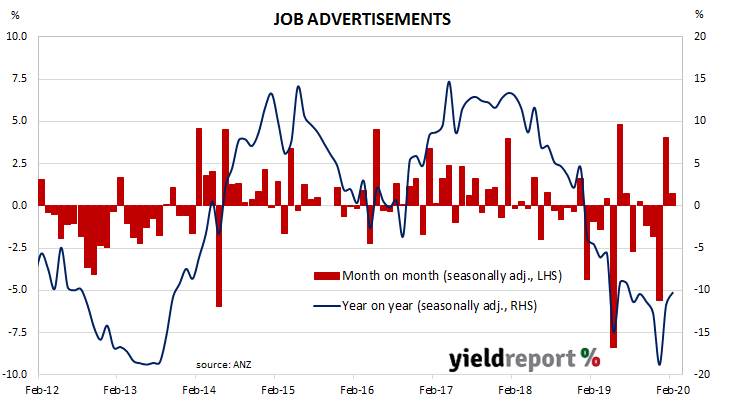From mid-2017 onwards, year-on-year growth rates in the total number of Australian job advertisements consistently exceeded 10%. That was until mid-2018 when the annual growth rate fell back markedly. 2019 was notable for its reduced employment advertising, along with a reversal of the gains in 2017 and 2018. Despite, the first two surveys of 2020 providing a positive note, economists are doubtful.
According to the latest ANZ figures, total advertisements increased by 0.7% in February on a seasonally-adjusted basis, following a 4.0% rise in January after that month’s figures were revised up. However, on a 12-month basis, total job advertisements were 10.2% lower than the same month last year, a modest improvement from January’s comparable figure of -11.7% after revisions.
ANZ senior economist Catherine Birch said, “This has been a surprise to the positive side; a welcome relief from the more negative data from the private sector on construction work done, capital expenditure, business conditions and confidence.” Domestic bond yields at the short end finished lower but, overall, local yields largely discounted significant overnight falls in US markets. By the end of the day, 3-year ACGB yields had shed 5bps to 0.45%, the 10-year yield slipped 1bp to 0.80% while the 20-year yield finished unchanged at 1.22%.
Domestic bond yields at the short end finished lower but, overall, local yields largely discounted significant overnight falls in US markets. By the end of the day, 3-year ACGB yields had shed 5bps to 0.45%, the 10-year yield slipped 1bp to 0.80% while the 20-year yield finished unchanged at 1.22%.
Expectations of another cut in the cash rate target hardened as traders suddenly became convinced the RBA would act in anticipation of a coronavirus-led slowdown. By the end of the day, March contracts implied a 25bps rate cut had been totally priced in, up from the previous day’s 18%. April contracts factored in a March rate cut plus a 76% chance of an additional rate cut at the start of the month. Previously, April contracts had implied a 73% chance of just one rate reduction.

